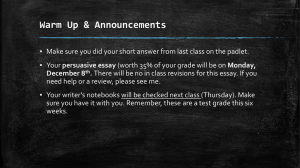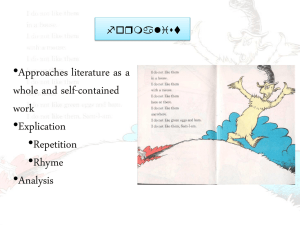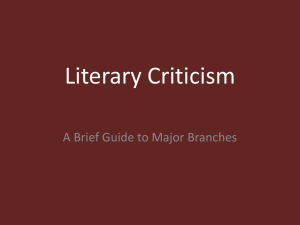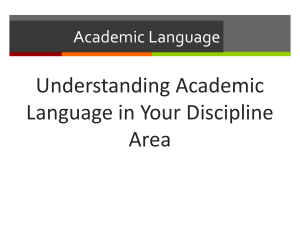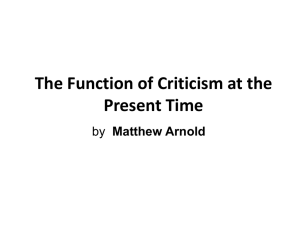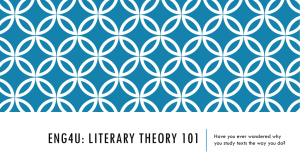Art of Fiction Paper 3 Criticism Assignment and Tips
advertisement
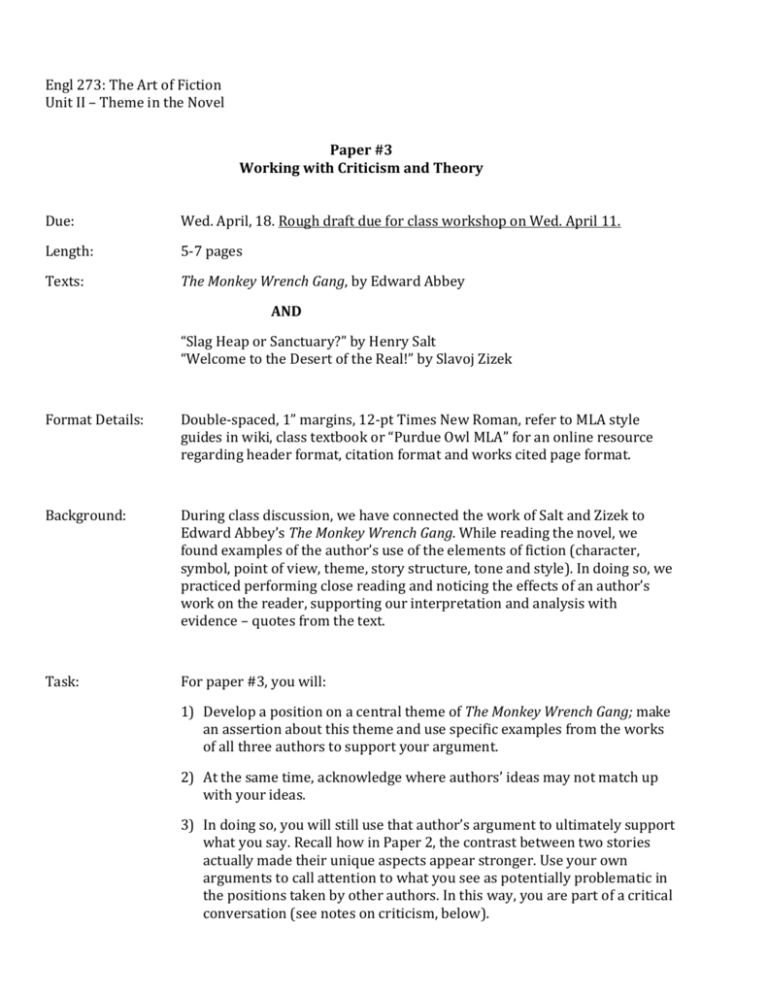
Engl 273: The Art of Fiction Unit II – Theme in the Novel Paper #3 Working with Criticism and Theory Due: Wed. April, 18. Rough draft due for class workshop on Wed. April 11. Length: 5-7 pages Texts: The Monkey Wrench Gang, by Edward Abbey AND “Slag Heap or Sanctuary?” by Henry Salt “Welcome to the Desert of the Real!” by Slavoj Zizek Format Details: Double-spaced, 1” margins, 12-pt Times New Roman, refer to MLA style guides in wiki, class textbook or “Purdue Owl MLA” for an online resource regarding header format, citation format and works cited page format. Background: During class discussion, we have connected the work of Salt and Zizek to Edward Abbey’s The Monkey Wrench Gang. While reading the novel, we found examples of the author’s use of the elements of fiction (character, symbol, point of view, theme, story structure, tone and style). In doing so, we practiced performing close reading and noticing the effects of an author’s work on the reader, supporting our interpretation and analysis with evidence – quotes from the text. Task: For paper #3, you will: 1) Develop a position on a central theme of The Monkey Wrench Gang; make an assertion about this theme and use specific examples from the works of all three authors to support your argument. 2) At the same time, acknowledge where authors’ ideas may not match up with your ideas. 3) In doing so, you will still use that author’s argument to ultimately support what you say. Recall how in Paper 2, the contrast between two stories actually made their unique aspects appear stronger. Use your own arguments to call attention to what you see as potentially problematic in the positions taken by other authors. In this way, you are part of a critical conversation (see notes on criticism, below). Potential Paper #3 Organization/Structure Intro: MWG/Zizek/Salt background that leads up to discussing a central theme. Introduction of the theme – defining it and ultimately taking a stand (thesis) Body Paragraphs: evidence of how this theme appears in MWG connections to Zizek connections to Salt acknowledgements of differences in authors’ (including your own) styles, tones, purposes Hints on organizing body paragraphs: organize by sub-theme instead of by author. For example, don’t discuss MWG all at once, then Salt, then Zizek. Move back and forth between all three authors and how they relate to the theme in different ways ideas for sub-themes: use different paragraphs to discuss overall categories each author fits into, such as political aims/ideology, writing style/use of particular words/phrases and their effect on the reader, the author’s tone, or any other category of your choosing that you relate back to your central theme. Conclusion: Re-state the theme and how the authors add to it; summarize what you have discussed in the paper and provide additional “food for thought.” Harris, Joseph. Rewriting: How to Do Things With Texts. Logan, UT: Utah State UP, 2006 “CRITICISM” AND “WRITING WITH CRITICISM” TIPS What is criticism? In an academic setting, the word “criticism” typically refers to scholarly, academic criticism. Academic criticism is writing that makes an argument following the expectations of scholars in the field; those expectations typically include high standards for the use of evidence, theory, developments in understanding, and argumentation with other scholars. Academic criticism typically appears in the form of articles published in academic journals or books. (Those articles can then be scanned into electronic databases such as JSTOR.) Academic criticism is typically peer reviewed, which means that scholars in the field have read and critiqued it before approving it for publication. Academic criticism always uses citation, giving credit to other sources. These articles are aimed at other scholars—not at the general public. As a college student, you need to enter into this world of scholarship; you must learn the most current, cutting-edge, and “best” ideas and debates in your area of study. Academic criticism typically follows an academic field’s expectations for scholarship. For example, a biology article would have to report on lab results, a sociology article might explain a survey, and a literature article might apply a theory to a literary text. What is writing with criticism? Writing with criticism is a conversation about texts. In this form of writing, you connect your ideas to the ideas that appear in an academic article. Imagine yourself talking to—agreeing with or arguing with—the scholar who wrote the article. When you take part in this conversation, you advance your own view. You “take on” the arguments made by critics in order to advance your own ideas, interpretations, and arguments. This is why it is necessary to form an interpretation of the story first. Before you engage the criticism, you should have your own ideas (your thesis!) about the story. How do I read criticism? Criticism—a journal article, book chapter, or essay—should be read as carefully as literary writing. You should read closely, trying to understand what the author has to say and how he or she goes about saying it. You should get a sense of their position, their objective. How do they advance their claims? How do I engage in criticism? The idea is to take part in the conversation. Demonstrate your understanding of what others are saying, perhaps by summarizing their arguments, then suggest where you agree and disagree. Important: set out your own unique interpretation of the story. The following quotes from Joe Harris offer some great advice on using criticism: Harris, Joseph. Rewriting: How to Do Things With Texts. Logan, UT: Utah State UP, 2006 “The goal of such writing is not to have the final word on a subject, to bring the discussion to a close, but to push it forward, to say something new . . . A dialogue is not a debate. You don’t win a conversation, you add to it.” (35-6) “There are many writers who don’t so much argue for a single claim or position as think through a complex set of texts and problems.” (17) “By noting what others have had to say on a subject, defining where their thinking ends and yours begins, you can make your own stance as a writer all the more clear ... In doing so, you will often begin to see the shape of a dialogue begin to appear in your own writing.” (73) Writerly “Moves” to Make with Criticism These are called “moves” by Harris because he wants to capture the dynamic nature of responding to texts and to ideas. You should never simply repeat ideas, you do things with them – interpret them, employ them, disagree with them, etc. Try to use these “moves” in your own work. 1. Coming to terms: Demonstrate that you understand the project of the writer, his or her method, objectives, and conclusions. Be able to summarize their points and relay the gist of their argument, paraphrasing some of it and using quotes to add special emphasis to certain points and show the writer in their own language. This is never simply a summary, but a way of putting an author’s work in your own words so you can use his or her ideas to propel your own. 2. Forward the ideas: Like in email, you can reply, or you can forward. When you forward, you are not responding directly to the writer, you are sending his or her text ahead of you to a third party, often with your own message added in. In academic writing, you want to forward not just the text, but the ideas, adding your own comments and giving them your own spin. 3. Counter the limitations: Some ideas will have holes in them, or aspects with which you disagree. One way of using critical writing is to articulate these limitations so that you can put forward your own counter-claim. We need not waste all our time refuting points – if an author is entirely wrong, it may just be best to discard their ideas. We counter ideas that we think have some merit, but some flaws. 4. Take an approach: Try adopting an idea or method that another writer has used, and applying it to something new. For example, if a critic examines a story by identifying some heavily charged, repeated words, and discusses the shifting meanings of those words, you could do the same to a different story. This advances the method, allowing you to test and discuss its strengths and weaknesses, and to further examine the implications of that style of reading a text. Harris, Joseph. Rewriting: How to Do Things With Texts. Logan, UT: Utah State UP, 2006
